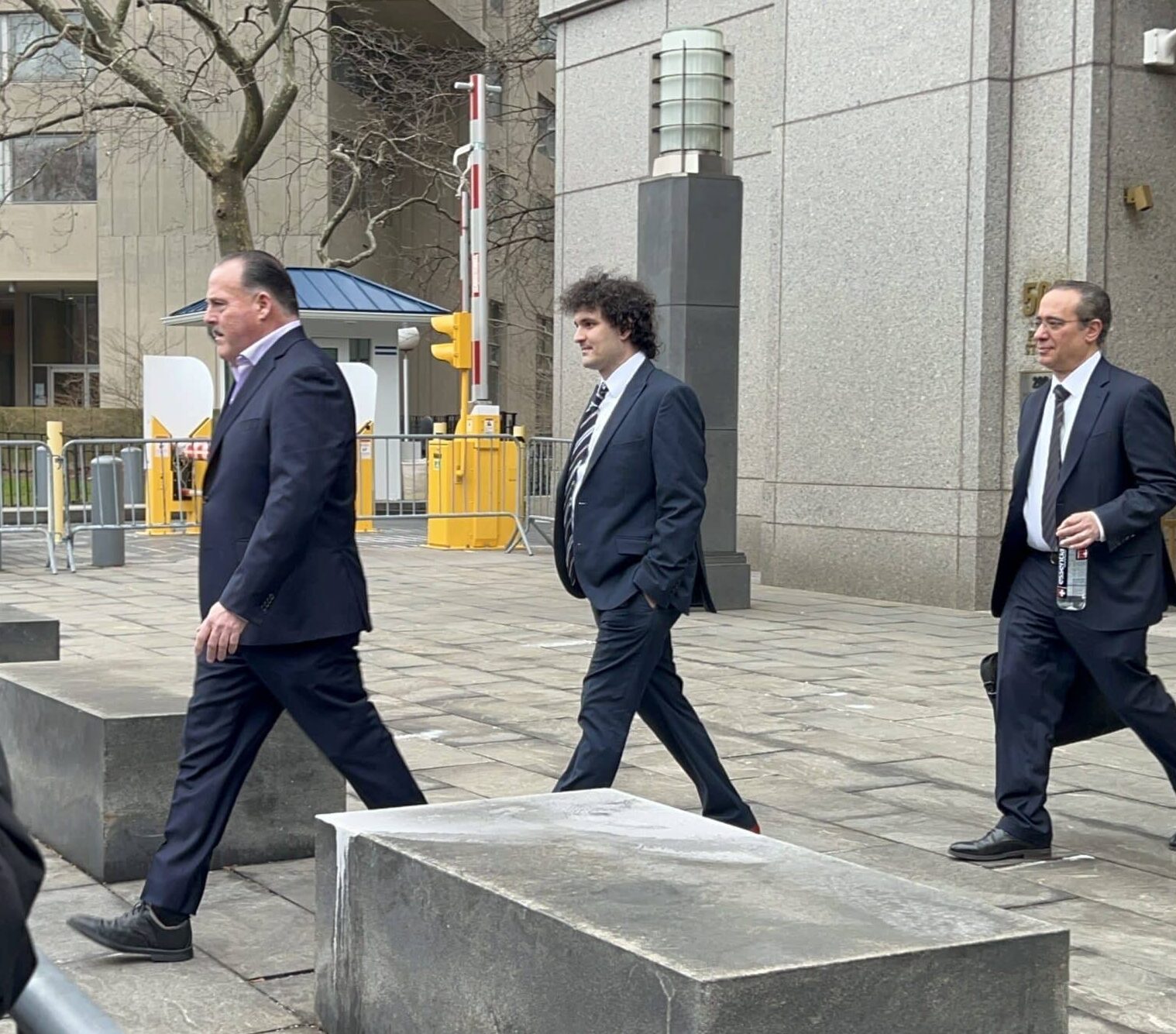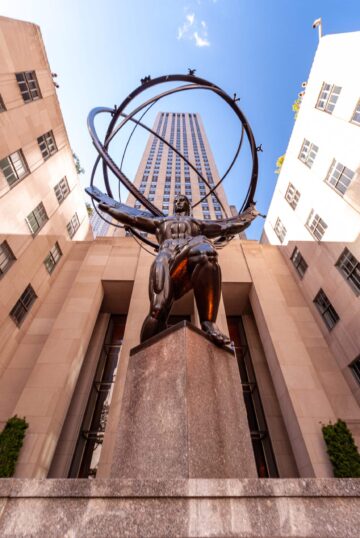As part of his sentence, SBF was ordered to forfeit a whopping $11 billion in assets, but what will he really end up paying? And how much time will he actually spend in prison?

Sam Bankman-Fried walking out of the courtroom ahead of his trial in The United States District Court for the Southern District of New York last fall.
(Unchained/Laura Shin)
Posted March 29, 2024 at 7:15 am EST.
One of the perhaps unexpected elements of FTX founder Sam Bankman-Fried’s sentencing on Thursday was that, in addition to serving 25 years in prison, he was ordered to forfeit $11 billion in assets. But SBF, whose net worth was once estimated to be as much as $26.5 billion based mostly on his ownership stake in the now-bankrupt FTX and its related token, clearly doesn’t have anything approaching that amount of money anymore. So what is he really expected to pay, and to whom?
Speaking on an episode of Unchained, Sam Enzer, a partner at Cahill Gordon, explained that in cases of fraud, the government has the power to seize any and all assets held by the perpetrator, even those that are unrelated to the fraud, for its behalf.
This means that everything SBF owns in his own name or has de facto ownership of (e.g., if he bought something and gave it to someone else) is fair game. Enzer offered up as a prime example the storied $35 million penthouse in the Bahamas where SBF and his fellow FTX and Alameda executives lived.
Read more: How Sam Bankman-Fried’s Sentencing Went Down: A Timeline of Events
“If that’s in his name and it’s still out there, [the government] could seize it, sell it, and use the proceeds to compensate victims,” Enzer said (in fact, the penthouse has already been seized by the bankruptcy estate since it was bought in part with customer funds).
In Bankman-Fried’s case, Enzer said that rather than seizing Bankman-Fried’s funds for itself, the government has elected to return the funds to the victims of the fraud.
The fact that the FTX bankruptcy estate is also seeking to recover assets for creditors raises an interesting legal question of whether the government could go in and seize assets that are technically part of the bankruptcy estate to cover what Bankman-Fried owes, such as the Bahamas penthouse. But Enzer said this was unlikely.
Read more: FTX To Sell Two Thirds of Anthropic Stake for $884 Million
“[The government] will probably say that whatever assets have been determined by the bankruptcy court to be part of the FTX bankruptcy estate, they’re going to leave that there and that will be distributed through the process administered by the bankruptcy court,” Enzer said.
And what if Bankman-Fried is eventually released from prison and hasn’t paid off the $11 billion?
Enzer said the government is entitled to keep seizing SBF’s assets until the amount is fulfilled.
“The forfeiture judgment will continue to hang over him, even after he’s released,” Enzer said. “And like any debt, the government can collect on it.”
Details on SBF’s Jail Time and After
Enzer also shed light on aspects of SBF’s expected jail time and location, saying that he would likely get sentenced to a medium-security prison since he’s a nonviolent white collar criminal, and that the exact location would be decided by the Bureau of Prisons in the next few months.
Read more: Where Is Sam Bankman-Fried Likely to Serve His Prison Term?
As for how much time Bankman-Fried is likely to serve of his 25-year sentence, Enzer noted that he would get credit for all the time he’s been in custody, including during his expected appeals, though there’s no parole in the federal jail system.
There is, however, credit for being a good prisoner that can cut five to ten percent off the sentencing. And there are programs such as for inmates that are addicts and have gone to rehab to ask for less time, as well as for inmates to apply for compassionate release to reduce their sentences, such as what happened during the pandemic.
Read more: Is Prison Crypto’s New Glow-Up? Post-Incarceration Do Kwon and SBF Are Admired
Enzer suggested that after serving five or ten years, Bankman-Fried could argue he’s been a good inmate and apply for compassionate release to lessen his sentence.
Bankman-Fried was also ordered to serve three years of supervision after his release, which Enzer explained would consist of a probation officer being assigned to supervise him and make sure he complies with the rules of his release. The probation department could connect SBF with job placement programs and therapists but also can submit a violation report if he re-offends and have him sent back to jail.
UPDATE (March 29, 2024 7:50 a.m. ET): Updated details on the disposition of Bankman-Fried’s Bahama’s penthouse.
- SEO Powered Content & PR Distribution. Get Amplified Today.
- PlatoData.Network Vertical Generative Ai. Empower Yourself. Access Here.
- PlatoAiStream. Web3 Intelligence. Knowledge Amplified. Access Here.
- PlatoESG. Carbon, CleanTech, Energy, Environment, Solar, Waste Management. Access Here.
- PlatoHealth. Biotech and Clinical Trials Intelligence. Access Here.
- Source: https://unchainedcrypto.com/is-sam-bankman-fried-really-expected-to-pay-off-an-11-billion-judgment/
- :has
- :is
- :where
- $UP
- 127
- 15%
- 2024
- 25
- 29
- 31
- 33
- 35%
- 5
- 50
- 7
- a
- actually
- addition
- administered
- After
- ahead
- Alameda
- Alameda executives
- All
- already
- also
- am
- amount
- an
- and
- Anthropic
- any
- anymore
- anything
- appeals
- Apply
- approaching
- ARE
- argue
- AS
- ask
- aspects
- Assets
- assigned
- At
- back
- Bahamas
- Bankman-Fried
- Bankruptcy
- Bankruptcy Court
- based
- BE
- been
- behalf
- being
- Billion
- bought
- Bureau
- but
- by
- CAN
- case
- cases
- clearly
- collect
- compensate
- complies
- Connect
- consist
- continue
- could
- Court
- cover
- credit
- creditors
- Criminal
- Custody
- customer
- Cut
- de
- Debt
- decided
- Department
- details
- determined
- distributed
- district
- district court
- do
- Do Kwon
- Doesn’t
- down
- during
- e
- E&T
- elected
- elements
- else
- end
- entitled
- estate
- estimated
- Even
- eventually
- everything
- exact
- example
- executives
- expected
- explained
- fact
- facto
- fair
- fair game
- Fall
- Federal
- fellow
- few
- five
- For
- Forbes
- forfeiture
- founder
- fraud
- from
- FTX
- FTX Bankruptcy
- fulfilled
- funds
- game
- gave
- get
- Go
- going
- gone
- good
- gordon
- Government
- Hang
- happened
- Have
- he
- Held
- High
- him
- his
- How
- However
- HTTPS
- if
- in
- Including
- interesting
- IT
- ITS
- itself
- jail
- JAIL TIME
- Job
- jpg
- Keep
- Kwon
- Last
- Leave
- Legal
- less
- light
- like
- likely
- location
- make
- March
- max-width
- means
- million
- money
- months
- more
- mostly
- much
- name
- net
- New
- New York
- next
- no
- noted
- of
- off
- offered
- Officer
- on
- once
- or
- out
- over
- own
- ownership
- owns
- paid
- pandemic
- part
- partner
- Pay
- paying
- penthouse
- percent
- perhaps
- placement
- plato
- Plato Data Intelligence
- PlatoData
- posted
- power
- Prime
- prison
- probably
- proceeds
- process
- Programs
- question
- raises
- rather
- really
- Recover
- reduce
- rehab
- related
- release
- released
- report
- return
- rules
- Said
- Sam
- Sam Bankman-Fried
- say
- saying
- sbf
- SBF’s
- SDNY
- seeking
- Seize
- seized
- seizing
- sell
- sent
- sentence
- sentenced
- serve
- serving
- shed
- since
- So
- Someone
- something
- Southern
- Southern District of New York
- spend
- stake
- States
- Still
- submit
- such
- supervision
- sure
- system
- technically
- ten
- term
- than
- that
- The
- The Bahamas
- their
- There.
- this
- those
- though?
- three
- Through
- time
- timeline
- to
- token
- trial
- two
- Unchained
- Unexpected
- United
- United States
- unlikely
- until
- use
- victims
- VIOLATION
- walking
- was
- WELL
- went
- What
- What is
- whatever
- whether
- which
- white
- whom
- whose
- will
- with
- worth
- would
- years
- york
- zephyrnet










